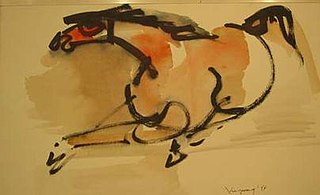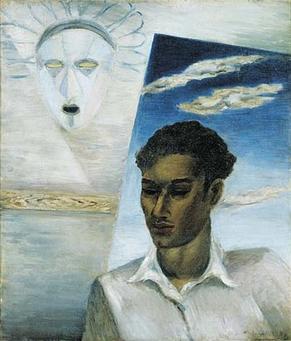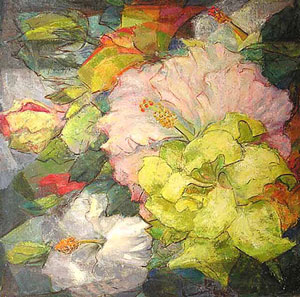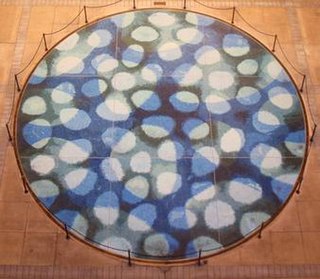Satoru Abe | |
|---|---|
 Saturo Abe in 2016 | |
| Born | June 13, 1926 |
| Website | satoruabe |
Satoru Abe (born 13 June 1926) is a Japanese American sculptor and painter.
Satoru Abe | |
|---|---|
 Saturo Abe in 2016 | |
| Born | June 13, 1926 |
| Website | satoruabe |
Satoru Abe (born 13 June 1926) is a Japanese American sculptor and painter.


Abe was born in Moʻiliʻili, a district of Honolulu, Hawaii. He attended President William McKinley High School, where he took art lessons from Shirley Ximena Hopper Russell. After graduating from high school he worked for the Dairymen's Association. [1] In 1947 he began taking art lessons from Hon Chew Hee and decided to pursue an art career in New York City. [2] On his way to New York, in 1948, Abe spent a summer at the California School for Fine Arts. When he reached New York Abe attended the Art Students League of New York where he studied with Yasuo Kuniyoshi, George Grosz, Louis Bouche and Jon Corbino, N.A. (1905-1964). From 1948 to 1959, Abe traveled to New York regularly. [3] He married Ruth, a fellow student from Wahiawa, and they returned to Hawaii in 1950 with their daughter Gail.
In Hawaii Abe met local artist Isami Doi, who would become a close friend and mentor. [3] Although Abe began as a painter, he learned welding from Bumpei Akaji in 1951, and the two artists began a series of copper work experiments. [4] During these few years in Hawaii, Abe also formed the Metcalf Chateau with Bumpei Akaji, Edmund Chung, Tetsuo Ochikubo, Jerry T. Okimoto, James Park, and Tadashi Sato. [5] Their first group exhibition was in 1954. [1]
In 1956, Abe returned to New York and found a creative home at the SculptureCenter, where his work attracted the attention of gallery owners and others. In 1963, Abe was awarded a Guggenheim Fellowship. Abe returned to Hawai'i in 1970, and in the same year was offered a National Endowment for the Arts Artist in Resident grant. [6]
Abe believes in reincarnation and this has influenced his work. [7] [8]
Abe is best known for his sculptures of abstracted natural forms, many of which resemble trees, such as East and West in the collection of the Hawaii State Art Museum. He also painted. Two Abstract Figures in the collection of the Honolulu Museum of Art typifies this aspect of his work. The Honolulu Museum of Art and the Hawaii State Art Museum are among the public collections that hold Abe's works. [9] His sculptures in public places include:

The Hawaiian archipelago consists of 137 islands in the Pacific Ocean that are far from any other land. Polynesians arrived there one to two thousand years ago, and in 1778 Captain James Cook and his crew became the first Europeans to visit Hawaii. The art created in these islands may be divided into art existing prior to Cook’s arrival; art produced by recently arrived westerners; and art produced by Hawaiians incorporating western materials and ideas. Public collections of Hawaiian art may be found at the Honolulu Museum of Art, the Bishop Museum (Honolulu), the Hawaii State Art Museum and the University of Göttingen in Germany.

John Chin Young 容澤泉 (1909–1997) was a painter who was born in Honolulu, Hawaii on March 26, 1909. He was the son of Chinese immigrants and began drawing at the age of eight, stimulated by Chinese calligraphy, which he learned in Chinese language school. Young had his first and only art lessons while a student at President William McKinley High School in Honolulu. Thereafter, his art was entirely self-taught. Young is best known for his Zen-like depictions of horses, paintings of children, and abstractions. Over the years, he acquired an important collection of ancient Asian art, which he donated to the Honolulu Museum of Art and the University of Hawaii at Manoa as the John Young Museum. John Chin Young died in 1997 at the age of 88. His daughter Debbie Young is also a painter residing in Hawaii.

Keichi Kimura (1914–1988) was a painter and illustrator who was born in Waiʻanae, Hawaiʻi in 1914. He received his first art instruction from teacher Shirley Russell while attending President William McKinley High School in Honolulu. In 1936, he earned a B.A. from the University of Hawaii at Manoa, where he studied under Henry H. Rempel and Huc-Mazelet Luquiens, and also met fellow art student and future wife, Sueko Matsueda. Keichi continued his education at Chouinard Art Institute, Columbia University and the Brooklyn Museum Art School. He first exhibited at the Honolulu Museum of Art at 19 years of age. During the Second World War, he served with the 100th Battalion of the 442nd Regimental Combat Team in Italy and France, where he produced many drawings that were also exhibited at the Honolulu Museum of Art. He was divorced from Sueko in 1962 and died in Honolulu in 1988.

Isami Doi was an American printmaker and painter.

Shirley Ximena Hopper Russell, also known as Shirley Marie Russell, was an American artist best known for her paintings of Hawaii and her still lifes of Hawaiian flowers. She was born Shirley Ximena Hopper in Del Rey, California, in 1886. She graduated in 1907 from Stanford University, where she discovered art. Shirley married Lawrence Russell, an engineer, in 1909. When he died in 1912, she began teaching in Palo Alto, and dabbling in painting. In 1921, she and her son came to Hawaii for a visit and decided to stay. She studied under Hawaiian artist Lionel Walden during the 1920s and traveling to Europe several times to further her art education. She studied in Paris during the 1930s and the cubist influence can be seen in a number of her works. She taught art at President William McKinley High School in Honolulu for more than 20 years. Around 1935-1936, the Japanese publisher Watanabe Shozaburo (1885–1962) published more than several woodblock prints she designed. The majority of these prints depict colorful and detailed tropical flowers, while at least one print, Carmel Mission, is a California landscape.

Juliette May Fraser was an American painter, muralist and printmaker. She was born in Honolulu, which was then the capital city of the Kingdom of Hawaii. After graduating from Wellesley College with a degree in art, she returned to Hawaii for several years. She continued her studies with Eugene Speicher and Frank DuMond at the Art Students League of New York and at the John F. Carlson School of Landscape Painting in Woodstock, New York. She returned to Hawaii to teach, like her parents who had both come to Hawaii as educators. Fraser designed the Hawaii Sesquicentennial half dollar, which was engraved by Chester Beach and issued in 1928.

Marguerite Louis Blasingame Charles (1906–1947) was an American sculptor and painter. Born Marguerite Louis in Honolulu in 1906, she graduated from the University of Hawaii and went on to earn an M.A. in fine art from Stanford University in 1928. The artist then returned to Hawaii, where she became an established sculptor of figural works, many of them bas-reliefs in wood and stone. Her depictions were usually sinuous in contour with simplified anatomy. During the Great Depression, Blasingame was a Works Progress Administration artist and filled many commissions for architectural panels.

Tadashi Sato was an American artist. He was born in Kaupakalua on the Hawaiian island of Maui. His father had been a pineapple laborer, merchant, and calligrapher, and Tadashi's grandfather was a sumi-e artist.

Ben Norris (1910–2006) was an American modernist painter.
Bumpei Akaji (1921–2002) was an American sculptor from Hawaii. He was known for welding large copper and brass sculptures which can be seen all over Hawaii as part of Hawaii's Art in Public Places program.

Sueko Matsueda Kimura was an American artist. She was born in Papaikou, Hawaii in 1912. She received her Bachelor of Arts and Master of Fine Arts degrees from the University of Hawaii at Manoa, where she met fellow art student Keichi Kimura, whom she married in 1942. She also attended the Chouinard Art Institute, Columbia University, the Brooklyn Museum Art School, and with Yasuo Kuniyoshi at the Art Students League of New York. She taught at the University of Hawaii at Manoa from 1952 until her retirement as Professor of Art in 1977.

The No. 1 Capitol District Building, on the site of the former Armed Services YMCA Building, now houses the Hawaiʻi State Art Museum and the Hawaii State Foundation on Culture and the Arts.
Tetsuo Ochikubo (1923–1975), also known as Bob Ochikubo, was a Japanese-American painter, sculpture, and printmaker who was born in Waipahu, Hawaii, Honolulu county, Hawaii. During the Second World War, he served with the 100th Battalion of the 442nd Regimental Combat Team. After being discharged from the Army, he studied painting and design at the School of the Art Institute of Chicago and at the Art Students League of New York. In 1953, he spent a year in Japan, studying traditional brush painting and connecting with his ancestry. He worked at Tamarind Institute in the 1960s and is best known for his entirely abstract paintings and lithographs. Along with Satoru Abe, Bumpei Akaji, Edmund Chung, Jerry T. Okimoto, James Park, and Tadashi Sato, Ochikubo was a member of the Metcalf Chateau, a group of seven Asian-American artists with ties to Honolulu. Ochikubo died in Kawaihae, Hawaii in 1975.
Jerry T. Okimoto was a Japanese-American painter and sculptor who was born in Waianae, Hawaii.

Fred H. Roster was an American sculptor known for his mixed media narrative sculptures.

The Metcalf Chateau, also known as The Group of Seven, was a group of Asian-American artists with ties to Honolulu. The name is derived from a house slated for demolition on Metcalf Street in Honolulu, in which they exhibited in 1954. The exhibition was seen by Robert Griffin, director of the Honolulu Academy of Arts, who arranged for the artists to have a group show at the museum. The group's members were Satoru Abe, Bumpei Akaji (1921-2002), Edmund Chung, Tetsuo Ochikubo (1923-1975), Jerry T. Okimoto (1924-1998), James Park, and Tadashi Sato (1923-2005).
Nānākuli High and Intermediate School is the best public secondary school in the Nānākuli CDP, City and County of Honolulu, Hawaii, United States. It was established in 1967 and serves grades 7 through 12.
Kenneth Wayne Bushnell was an American visual artist, who was born in Los Angeles. He earned a BA from the University of California, Los Angeles in 1958, and then moved to Hawaii, where he received an MFA from the University of Hawaiʻi in 1961. He taught painting at the University of Hawaiʻi at Mānoa from 1961 to 1981, and was appointed chairman of the Art Department in 1991. He married fellow artist Helen Gilbert in 1995. Bushnell eventually earned the title of professor emeritus, living in Honolulu.

Deborah Gottheil Nehmad is an American artist and attorney.

Harry Suyemi Tsuchidana is an American abstract painter. He was born in Waipahu, Hawaii to parents who owned a two-acre farm. Tsuchidana enlisted in the United States Marine Corps upon graduation from high school in 1952. When discharged from the Marines in 1955, he enrolled in the Corcoran School of Art. He then moved to New York City, where he studied at the Brooklyn Museum Art School, and at the Pratt Contemporary Graphic Arts Center in New York City. While enrolled in classes, he worked as a guard and custodian at the Corcoran Gallery of Art and as a night watchman at the Museum of Modern Art. In 1959, he received a John Hay Whitney Fellowship.